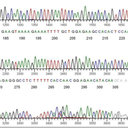[Detection of Entamoeba histolytica and Entamoeba dispar by PCR in children, less than five years of age with diarrhea, in Maracaibo, Venezuela. A preliminary study].
Keywords
Abstract
To determine the prevalence of Entamoeba histolytica as a producer of diarrhea, a study was conducted in children, less than five years of age, with diarrhea who attended several out patient clinics of the Servicio Aut6nomo Hospital Universitario, Maracaibo, Venezuela. A macroscopic and microscopic examination with physiological saline, lugol and Kinyoun staining were performed to the stool samples obtained. The remainder of the sample was frozen until DNA extraction, and PCR amplification was performed separately for E. histolytica and E. dispar. Microscopic examination showed no trophozoites and/or cysts of Entamoeba histolytica/dispar/moshkovskii, or intestinal coccidians in any of the 50 samples analyzed. Parasites detected were Giardia lamblia (6%), Blastocystis sp. (4%), Pentatrichomonas hominis (2%), Ascaris lumbricoides (2%) and Trichuris trichiura (2%). By PCR, six samples (12%) had DNA of E. dispar and two (4%) had DNA from E. histolytica; no child showed association of both amoebae. The two children who had E. histolytica were one-year-old. E. dispar was detected in younger children. We suggest that the prevalence of E. histolytica in children under five years is really low.



